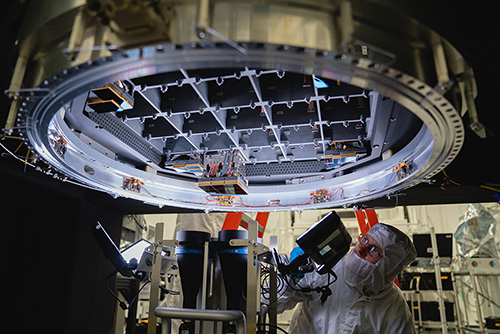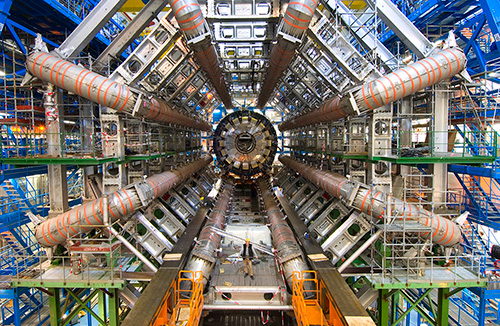Advisory Panel Issues Field-Defining Recommendations for U.S. Government Investments in Particle Physics Research
December 8, 2023
 enlarge
enlarge
The 2023 P5 report, Exploring the Quantum Universe: Pathways to Innovation and Discovery in Particle Physics, outlines research priorities for the field of high energy physics. (Particle Physics Project Prioritization Panel High Energy Physics Advisory Panel)
The following news release on the 2023 Particle Physics Project Prioritization Panel (P5) report is based on one issued today by the American Physical Society (APS) with added content specific to the U.S. Department of Energy’s (DOE) Brookhaven National Laboratory. For more information about Brookhaven Lab’s research in particle physics, contact: Karen McNulty Walsh, kmcnulty@bnl.gov, (631) 344-8350. For APS media inquiries, contact Anna Torres, torres@aps.org, (301) 209-3605.
WASHINGTON, D.C.—The High Energy Physics Advisory Panel (HEPAP) to the High Energy Physics program of the Office of Science of the U.S. Department of Energy and the National Science Foundation’s Division of Physics has released a new Particle Physics Project Prioritization Panel (P5) report, which outlines particle physicists’ recommendations for research priorities in the field. The 2023 P5 report was posted online yesterday and was voted on and accepted by HEPAP today.
The 2023 P5 report represents the major activity in the field of particle physics that delivers recommendations to U.S. funding agencies. This year’s report builds on the output of the 2021 Snowmass planning exercise—a process organized by the American Physical Society (APS)’s Division of Particles and Fields that convened particle physicists and cosmologists from around the world to outline research priorities. This membership division constitutes the only independent body in the United States that represents particle physics as a whole.
“The P5 report will lay the foundation for a very bright future in the field,” said R. Sekhar Chivukula, 2023 chair of the APS Division of Particles and Fields and a Distinguished Professor of Physics at the University of California, San Diego. “There are extraordinarily important scientific questions remaining in particle physics, which the U.S. particle physics community has both the capability and opportunity to help address, within our own facilities and as a member of the global high energy physics community.”
“We welcome the P5 report recommendations, which define a strong and balanced U.S. particle physics program based on input from the Snowmass community-wide process,” said Brookhaven National Laboratory Director JoAnne Hewett. “Building on our decades of expertise in high energy physics and facility design and operation, we are eager to actively engage and lead in developing, constructing, and operating the next generation of facilities and experiments to explore the Quantum Universe.”
 enlarge
enlarge
Among the P5 recommendations is continued support for high-luminosity upgrades at the Large Hadron Collider (LHC). (CERN)
The report includes a range of budget-conscious recommendations for federal investments in research programs, the U.S. technical workforce, and the technology and infrastructure needed to realize the next generation of transformative discoveries related to fundamental physics and the origin of the universe. For example, the report recommends continued support for the high-luminosity upgrades at the Large Hadron Collider (LHC), based in Europe, for the Deep Underground Neutrino Experiment (DUNE), based out of Fermilab in Illinois, for CMB-S4, a network of ground-based telescopes designed to observe the cosmic microwave background, and for the planned expansion of the South Pole’s neutrino observatory, an international collaboration known as IceCube-Gen2, in a facility operated by the University of Wisconsin–Madison.
“In the P5 exercise, it’s really important that we take this broad look at where the field of particle physics is headed, to deliver a report that amounts to a strategic plan for the U.S. community with a 10-year budgetary timeline and a 20-year context. The panel thought about where the next big discoveries might lie and how we could maximize impact within budget, to support future discoveries and the next generation of researchers and technical workers who will be needed to achieve them,” said Karsten Heeger, P5 panel deputy chair and Eugene Higgins Professor and chair of physics at Yale University.
New knowledge, and new technologies, set the stage for the most recent Snowmass and P5 convenings. “The Higgs boson had just been discovered before the previous P5 process, and now our continued study of the particle has greatly informed what we think may lie beyond the standard model of particle physics,” said Hitoshi Murayama, P5 panel chair and the MacAdams Professor of physics at the University of California, Berkeley. “Our thinking about what dark matter might be has also changed, forcing the community to look elsewhere—to the cosmos. And in 2015, the discovery of gravitational waves was reported. Accelerator technology is changing too, which has shifted the discussion to the technology R&D needed to build the next-generation particle collider.”
The United States participates in several major international scientific collaborations in high energy physics and cosmology, including the European Council for Nuclear Research (CERN), which operates the Large Hadron Collider, where the Higgs boson was discovered in 2012. The P5 report recommends that the United States support a significant in-kind contribution to a new international facility, the ‘Higgs Factory,’ to further our understanding of the Higgs boson. It also recommends that the United States study the possibility of hosting the next most-advanced particle collider facility, to reinforce the country’s leading role in international high energy physics for decades to come.
DOE’s Brookhaven National Laboratory contributes to many of the projects highlighted in the P5 report, including these major efforts:
Brookhaven Lab serves as the U.S. host laboratory for the ATLAS experiment, one of four major detectors at the LHC. ATLAS has opened new frontiers of knowledge about elementary particles and their interactions, including the 2012 discovery of the Higgs boson. Brookhaven Lab scientists contributed to that groundbreaking discovery and subsequent studies of Higgs properties, as well as ATLAS project management and experiment operations. They also run a state-of-the-art computing center for storing and sharing ATLAS data with collaborators around the world. Brookhaven physicists, engineers, and technical staff also helped design and build the magnets that steer the LHC’s beams of protons and other ions into collisions—including magnets enabling drastically increased collision rates for future discoveries.
In addition, the Brookhaven team has proposed ideas for and is dedicated to working closely with international and U.S. partners to develop a Higgs factory and its associated detectors. This facility, as recommended in the P5 report, would create copious numbers of Higgs particles and allow detailed, precision studies of their properties—potentially opening the door to discovering discrepancies between theory and experiment that could reveal new physics. The P5 panel also recommends dedicated R&D to explore a suite of promising future projects, including colliders that can reach even higher energies than Higgs factories. Brookhaven scientists are actively engaged in the development of technologies for one such approach—a machine that could collide particles called muons, heavy cousins of electrons.
 enlarge
enlarge
A wide-angle view of the interior of a prototype detector for the Deep Underground Neutrino Experiment (CERN)
Brookhaven Lab is also playing a leading role in DUNE. This Fermilab-based experiment will send beams of elusive subatomic particles called neutrinos hundreds of miles through Earth’s crust to detectors deep underground in South Dakota. Understanding how neutrinos change as they travel may help unravel mysteries about how our universe evolved, including potentially an asymmetry between matter and antimatter that accounts for our universe being composed mostly of matter. Brookhaven physicists and staff helped develop the methods for creating neutrinos, simulations for testing and controlling characteristics of the beam, specialized electronics and other detector materials needed to study key neutrino characteristics, and the software and computational tools that will be used to capture neutrino signals and process vast quantities of data. Brookhaven scientists are leading the design of a third underground detector module for DUNE, highlighted in the P5 report as part of a re-envisioned second phase of this project.
 enlarge
enlarge
One of the first Brookhaven-Lab-built sensor-array rafts being installed in the LSST camera. (SLAC National Accelerator Laboratory)
Going beyond the secrets of the matter that makes up our world and its scantly present antimatter partner, Brookhaven scientists seek to explore the unknowns of so-called dark matter and dark energy, which are highlighted among the scientific drivers for new discoveries by the P5 panel and together make up more than 95% of our universe. One tool for this research is a telescope that will be housed at the Vera C. Rubin Observatory high on a mountaintop in Chile. The DOE-funded effort to build the camera for the telescope was managed by SLAC National Accelerator Laboratory. Brookhaven Lab led construction of the camera’s 3.2 gigapixel “digital film”—the biggest charge-coupled device (CCD) array ever built—and will support the telescope’s Legacy Survey of Space and Time (LSST). LSST will be an unparalleled wide-field astronomical survey of our universe—wider and deeper in volume than all previous surveys combined.
Brookhaven Lab is also actively engaged in developing small- and medium-scale facilities and experiments and in building capabilities in machine learning/artificial intelligence, quantum information science, and microelectronics that will help to push the frontiers of discovery in high energy physics with potential benefit for other fields. The Lab is also committed to attracting, building, and supporting a diverse workforce to carry out these ambitious research programs, and to fostering a climate of innovation.
# # #
Activities of the Particle Physics Project Prioritization Panel are supported in part by
the American Physical Society’s Division of Particles and Fields
The American Physical Society is a nonprofit membership organization working to advance and diffuse the knowledge of physics through its outstanding research journals, scientific meetings, and education, outreach, advocacy, and international activities. APS represents more than 50,000 members, including physicists in academia, national laboratories, and industry in the United States and throughout the world.
Brookhaven National Laboratory is supported by the Office of Science of the U.S. Department of Energy. The Office of Science is the single largest supporter of basic research in the physical sciences in the United States and is working to address some of the most pressing challenges of our time. For more information, visit science.energy.gov.
Follow @BrookhavenLab on social media. Find us on Instagram, LinkedIn, Twitter, and Facebook.
2023-21588 | INT/EXT | Newsroom










